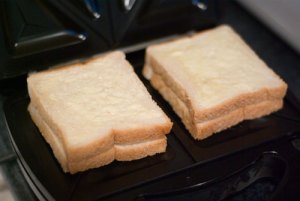
What are “Maultaschen”? Well, think of giant ravioli, filled with a meat and spinach. Almost everywhere in Germany, especially in the South, you will find them in the supermarkets and as soup in many traditional restaurants. I have always liked them, but when I visited my aunt and uncle a while ago, the homemade ones were a total revelation. My aunt was so kind to give me her recipe:
MAULTASCHEN
1 tablespoon oil
100 g bacon
1 cup diced onion
1 cup sliced leeks
500 g / 1 pound ground beef
500 g / 1 pound sausage meat or Leberkäsbrät (very finely ground)
250 g / 1/2 pound frozen spinach leaves
2 day-old rolls or 6 slices toast, cut into cubes
4 eggs
1 cup fresh parsley, chopped
salt and pepper
nutmeg, freshly ground
2 packages ready-made pasta dough or wontons

First of all, when you’re buying sausage meat, look for the very finely ground and well-seasoned stuff. Ask your butcher for it. It’s really easy when you live in Bavaria, because then you just buy a raw Leberkäse.
Nobody really knows why it is called “Leberkäse”, ie liver cheese – it contains neither liver nor cheese. It’s more like a regular sausage, but it is baked in this aluminum pan until it is cooked through and has formed a thick dark crust. Then you cut it in slices and serve it in 2 halves of a regular white roll, along with mustard. Bavarian fast food.

This is all about preparation – the French call it “mise en place” – so while the spinach thaws, set up your meat grinder. Then chop and drain the spinach.
Mine is a Kitchen Aid attachment, but feel free to use whatever you have. I have no experience in this, but maybe if you bought ground meat, you could also use a food processor.

Cut the onion into cubes, no need to be exact here. It will go through the meat grinder anyway.

Same with the leeks, just cut them into rings. I had some left from those 1 kilogram packages they sell around here. So I just let it thaw.

And also cut the parsley. It was a whole plant I bought at the supermarket.
Don’t forget about the bacon. Just cut it into strips. Cut the rolls into 1-inch cubes and have the rest of the ingredients ready.

Heat up the oil in your biggest pan and cook the bacon until it has rendered most of the fat but is not yet crispy. Add the leeks and onions and also cook them until they are soft, but are not getting any color. Set it all aside and let it cool.

No it’s time for the meat grinder. I like to make my own ground meat, so I bought a nice piece of beef, cut it into long strips and put them in the freezer for 30 minutes. Then the meat is cold but not frozen, perfect for grinding. Some people also recommend freezing the whole meat grinder (maybe not the handle if you’re using a hand-powered one).
Anyway, once you have ground meat, fill the bacon-onion mixture into the grinder and work it through. And after that, give the bread a ride.
By the way, this is a great way to clean your meat grinder, whether you use bread in your recipe or not. The bread soaks up quite a bit of the fats and juices that stay behind in the mechanism. And cleaning all the nooks and crannies is definitively easier with bread crumbs instead of gooey meat pieces.

Now for the rest of the ingredients: add sausage meat, parsley, chopped and drained spinach and eggs. And of course salt, pepper and quite a bit of ground nutmeg.
Pleeeeeease always buy whole nutmeg and grind it yourself when you need it. It’s no work at all and it tastes so much better than the pre-ground stuff.

Mix it all, either with a big spatula or using the paddle attachment of your Kitchen Aid. Just give it a couple of turns on the very low setting. Great if you’re having RSI (repetitive strain injury) or carpal tunnel problems.
See, I should have chopped the spinach more finely.
If the filling seems too soft, add a handful of breadcrumbs.

The store-bought pasta dough I bought was a fiasco – though it worked great in the lasagna. As it was Sunday, I had to make a quick pasta dough myself and without a pasta machine or even a decent rolling pin, well, the looked more like the “dumplings of Doctor Caligari”, as Alton Brown puts it.
Cook them in batches in hot salty water or broth and serve them with the broth and a potato salad.

I had tons of filling left, so I shaped it into half domes with my regular measuring tablespoon, set them on a freezer drawer and froze it over night. Then you can easily bag and tag the little meat balls and use them as a filling later on when you found a decent pasta dough at your supermarket. Or a pasta machine.

















































































